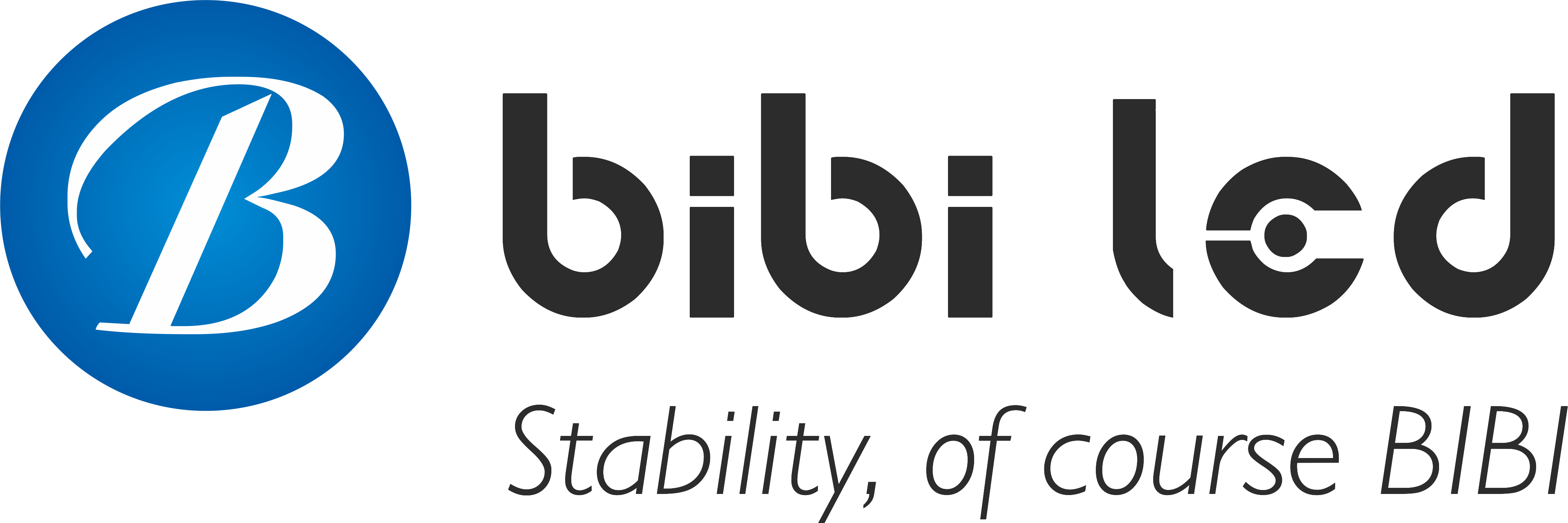Introduction
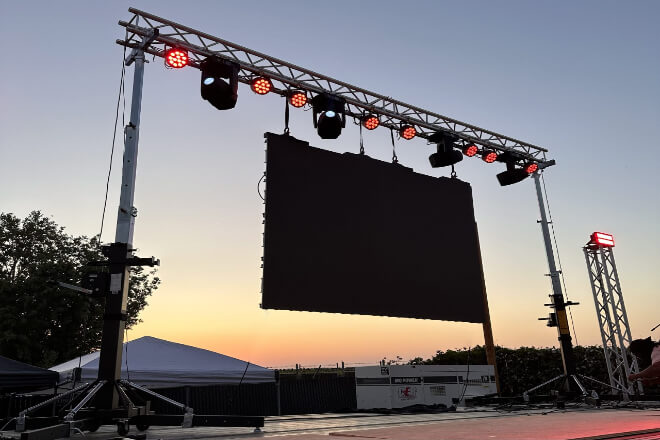
LED display screens are everywhere, from bustling commercial centres to busy transportation hubs, and they undertake the important tasks of information transmission and visual display.
However, a seemingly simple but often overlooked problem may seriously affect its effect: the LED display screen is installed too high, so can the audience really see it clearly?
Table of Contents
1. Will it really affect the viewing if it is installed too high?
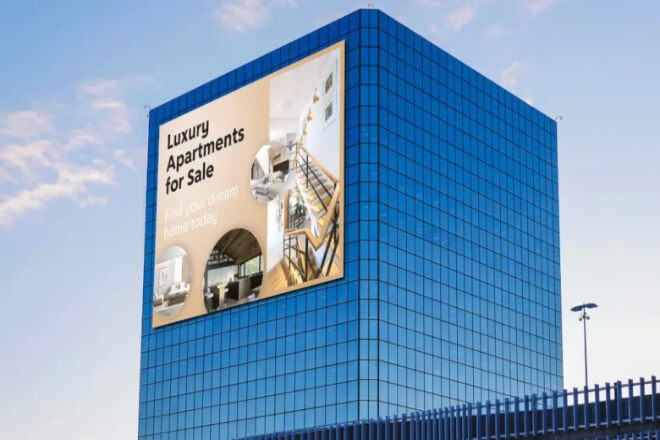
The installation height of the LED display screen has a great impact on the viewing effect.
If it is installed too high, the audience needs to look up to see the screen, which often feels uncomfortable and even affects the picture clarity and information transmission.
In natural conditions, the upward viewing angle of human eyes when viewing objects generally does not exceed 15 degrees. If it exceeds 30 degrees, it is easy to get tired and uncomfortable.
Looking up at the screen for a long time will make your neck sore and your eyes tired, especially in places such as shopping malls and exhibition halls where you need to stay for a long time.
The limit of the head tilting back is about 50 degrees. If it exceeds this angle, it is basically difficult to see the screen comfortably.
“The deviation angle of sight” refers to the angle between the eye’s sight and the vertical direction of the screen when watching.
The larger the angle, the worse the brightness and colour performance of the screen will be, and the details will be blurred.
The light of the LED screen is directional. If it leaves the optimal viewing angle range, the colour will be lighter, and the picture will be grey.
The best vertical viewing angle of many LED screens is about 60 degrees. Beyond this range, the image quality will be significantly reduced.
Different scenes have different tolerances for screen height. In outdoor squares, the audience is far away and standing to watch. It is okay to install the screen higher, which can ensure long-distance visibility.
However, in places such as shopping malls, exhibition halls, or subway stations where people are close and stay for a long time.
It is not appropriate to install a screen that is too high. The audience will feel tired, and the information will not be easy to capture quickly.
2. Reasonable range of viewing distance and elevation angle of the LED display screen
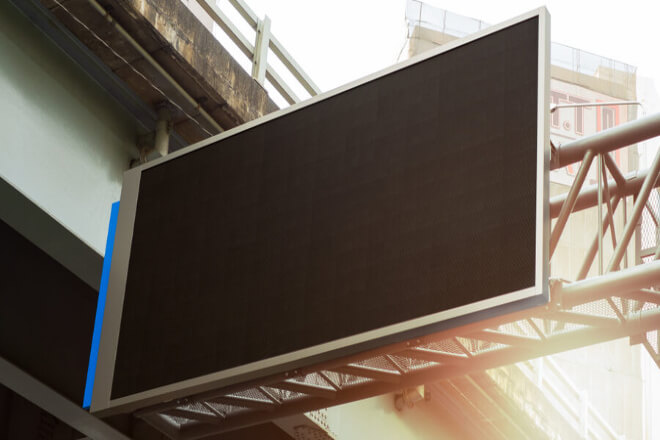
When installing an LED screen, in addition to the height of the screen, you must also consider how far you stand and how high you look up.
1). How to match viewing distance and elevation angle?
The viewing distance is the straight-line distance between you and the screen, and the elevation angle is the angle at which you raise your eyes when you look at the screen.
If the distance is close, the angle at which you raise your head may become larger, and you will feel tired when looking at it.
If the distance is far, the screen can be installed higher, and it will not be too strenuous to raise your head.
Generally speaking, it is best not to look up more than 15 degrees. If it is too high, your neck will feel uncomfortable, and your eyes will be easily tired.
The angle of left and right viewing should be within 30 degrees, so that the colour and picture can be beautiful and will not be deformed or distorted.
2). Use the “golden viewing angle” to find the height
The “golden viewing angle” is to find the most comfortable angle for everyone to watch the screen.
When installing the screen, ensure that the angle between the line of sight and the centre of the screen does not exceed 15 degrees when most people are standing or sitting.
For example, assuming that the height of the human eye is 1.6 meters and it is 5 meters away from the screen.
It is more appropriate to install the bottom edge of the screen at about 2.2 meters. In this way, you don’t need to look up too much, and the picture looks clear.
3). Dot pitch and optimal viewing distance
The dot pitch of the LED screen actually determines the closest distance to the screen.
The smaller the dot pitch, the finer the display, which is suitable for close viewing; the larger the dot pitch, the better for long-distance viewing.
There is a simple formula:
Optimal viewing distance ≈ dot pitch (mm) × 100
For example, if the dot pitch is 3 mm, the optimal viewing distance is about 3 meters. If the dot pitch is 5 mm, the optimal distance is 5 meters.
When installing the screen, this distance must also be taken into account to ensure that everyone can see clearly and will not feel that the screen is “grainy”.
In summary, when installing an LED screen, you must consider how far you stand and how high you look up, control the elevation angle to no more than 15 degrees.
And then choose the screen size and installation height according to the dot pitch, so that it looks comfortable and the effect is the best.
3. Is the content design of the LED screen suitable for high installation?
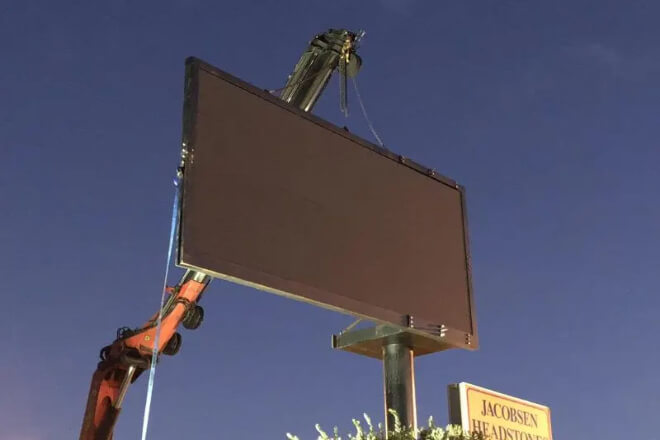
When the LED display is installed at a relatively high position, the content design must be adjusted accordingly to ensure that the audience can clearly see the information from a distance.
1). Large fonts and simple animations are more suitable for high-position LED displays
The viewing distance of high-position LED displays is far, and the font is too small or the content is too complex, which makes it difficult for the audience to see clearly.
Therefore, when designing, large fonts should be used, and the content should be kept concise and clear, avoiding piling up too many details.
It is also recommended to use simple and smooth effects for animations, avoiding being too fancy, so that the key points can be quickly captured when watching from a distance.
2). Colour contrast and brightness improvement
In order to enhance the recognition at a long distance, the content design of the LED display should focus on colour contrast.
Such as bright text with a dark background, to ensure that the information is eye-catching and clear.
In addition, the brightness should be adjusted high enough, especially in outdoor or bright light environments, to ensure that the picture will not be disturbed by ambient light and still look vivid.
3). The necessity of partitioning to display different types of content
For large high-position LED displays, it is a good idea to partition and display different types of content reasonably. For example, one area displays large headlines and important notifications.
Another area displays animations or scrolling subtitles, so that the levels are clear and the audience can find the information they care about faster.
Partitioning can also allow the content to flexibly adjust the display time and form according to priority, improving the overall information communication effect of the LED display.
In short, the content design of high-mounted LED display screens should highlight “big, simple, and bright”.
And combined with partition display, to ensure that it is still clear and easy to understand when viewed from a distance, and the information is effectively conveyed.
4. Which scenes are suitable for "high installation" and which are not?

Whether the LED display screen is installed high or not should be determined according to the specific usage scenario and audience needs. The higher the better.
The installation height directly affects the audience’s viewing experience and information communication effect, so it is very important to choose a suitable installation location.
1). Scenes suitable for high installation
1.1). Building advertising
Building advertising LED display screens are generally installed at a higher position in the building, facing passers-by and vehicles at a distance.
The LED screen is large in size, and the content is mostly concise and eye-catching brand promotion or promotional information, which can be seen clearly by the audience without getting close.
High installation can expand the screen’s visible range, increase advertising exposure and visual impact, and is very suitable for this outdoor environment.
1.2). Concert long-range screen
The audience at the concert is large, and the distribution range is wide, and it is far away from the stage.
Hanging the LED screen high on both sides or at the back of the venue allows more people to see the real-time stage images and visual effects, avoiding missing important content due to line-of-sight obstruction.
In this type of scene, high installation is not only conducive to viewing vision, but also convenient for safety management.
1.3). Traffic guidance screen
Traffic guidance LED screens are usually set in prominent locations such as road viaducts and intersections.
Which are convenient for drivers and pedestrians to quickly obtain traffic information and guidance from a distance.
High installation allows the screen to appear earlier in the field of vision, helping drivers to make judgments in advance, improving road safety and traffic efficiency.
2). Scenes not suitable for high installation
2.1). Retail window
The retail window LED screen faces close passers-by and potential customers, and the audience often stops to take a closer look at the goods and promotional information.
If the screen is installed too high, the audience needs to look up to watch, which is not only uncomfortable, but also may miss details, affecting consumers’ stay time and willingness to buy.
2.2). Close-range interactive screen in the exhibition hall
The LED display screen in the exhibition hall is often used to display detailed exhibits or interactive experiences, and the audience needs to observe and operate at close range.
High-position installation will make interaction difficult, screen details difficult to discern, and reduce the visiting experience and exhibition effect.
2.3). Supermarket entrance guide screen
The guide screen at the entrance of the supermarket is mainly used to guide customers to quickly obtain in-store information and promotional content.
If it is installed too high, it will make it difficult for customers to grasp the key points at first glance, prolong the time to find information, and reduce the efficiency of guidance.
3). Analysis of audience attention focus in different scenarios
In the scene of high-mounted LED screens, the audience is usually at a long distance, with scattered vision, and pays more attention to the overall colour effect of the screen and large-area dynamic pictures.
Which is suitable for conveying simple and eye-catching information, such as advertising slogans, digital countdowns or traffic instructions.
In close-range scenes, the audience’s attention is more focused on content details and text information, and they may also interact with the screen.
At this time, the content needs to be clear and delicate, the font is moderate, and the animation should not be too complicated to ensure smooth viewing.
If the screen is installed too high, the audience will feel alienated, and it will be difficult to fully participate in and understand the content.
5. How can we solve the problem of "too high to see" through technical means?
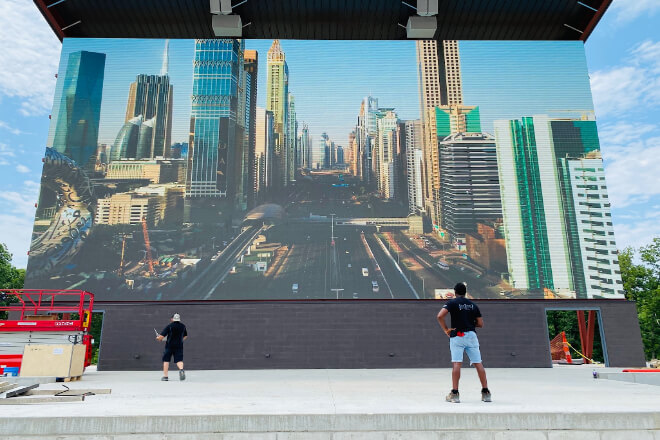
LED display screens are installed high, and it is easy to get tired when looking up, and it is common to have problems seeing things clearly.
But in fact, there are many technical methods that can help, so that everyone can see more comfortably, and the picture is clearer.
1). Micro-bend screen and oblique installation design
Now, there is a kind of LED screen called a micro-bend screen, which means that the screen is slightly bent forward so that when the audience looks up, the picture is not easily deformed, and the brightness is more uniform.
There is also an oblique installation, where the screen is installed slightly tilted downward, not completely vertical, so that people look more natural and the picture is better.
2). Tilt mounting frame, easy to adjust the angle
In order to adjust the angle of the screen, the mounting frame that can adjust the tilt angle will be used during installation, just like installing a bracket that can “nod” the screen.
You can first calculate the height and distance of the audience’s eyes from the ground, and adjust it to an elevation angle of less than 15 degrees to ensure that it will not be too hard to look up, and to achieve the best brightness and clarity of the picture.
3). Remote synchronisation and mirror split screen
Another smart way is to install a small screen directly below or next to the main screen, and synchronise or mirror the content with the main screen.
So that people at close range do not need to look up at the large screen at a high distance, and the details can be seen more clearly.
This trick is very practical in large venues or outdoor activities, taking into account the needs of both long-distance and close-up audiences.
In short, don’t be afraid of installing it high. If you can’t see it clearly, you can adjust it with a slightly curved screen, an oblique mounting design and an adjustable tilt bracket.
Combined with split-screen synchronisation, everyone can watch comfortably, and the picture is better.
6. Conclusion
Through the above analysis, we understand that the installation height of the LED display has a vital impact on the viewing experience.
Whether from the physiological limitations of the human eye or from the perspective of content design and scene requirements, a reasonable installation height is the key to ensuring the effective communication of information.
Finally, if you want to know more about LED displays, please get in touch with us.
